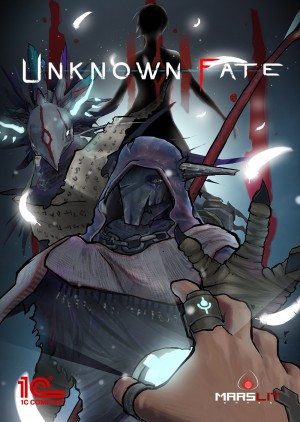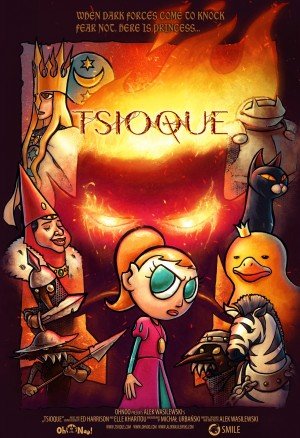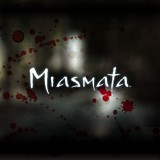Review for Unknown Fate

Note: Unknown Fate is available in both VR and non-VR versions. This review is based solely on the standard PC version of the game.
Sometimes when developers blend game types together, interesting things can result. Sometimes whole new subgenres can even spring into existence from such experiments. Marslit Games’ first-person 3D platforming adventure Unknown Fate is not one of those pioneers. Despite an interesting, off-kilter fantasy environment and a few intriguing game mechanics, the platforming is not particularly inspired, while the storytelling is repetitive and undercut by an adamant refusal to answer even basic questions.
Events open with the protagonist on a desolate street overlooking a house on a dark and stormy night. Approaching the house prompts a short black-and-white flashback memory showing one mysterious figure hauling another away. As the flashback fades and the view returns to the street, things have changed. The road is fractured, the surrounding land has disappeared in a grey haze, and a winged whale floats by overhead. Then things get weird, as you follow a glowing female form until you’re pulled through a portal into what may or may not be the dream world. All this happens within the first two minutes of bcinematic sequences and controlled gameplay. Unfortunately, after that further story progression is much more restrained.
You start out playing a character who has forgotten… well, everything. He doesn’t know his name or how he got here, and he doesn’t remember his past. Trapped in this strange fantasy land, the only thing he does know is that he must go on and discover the truth about who he is. In short order, he starts to meet the denizens of this new place, all of whom are obstinately unhelpful. Whenever he demands to know what’s going on, they universally reply that he’s either not ready to know or that it’s not the right time.
Any amnesiac setup demands that at some point the character’s identity be revealed, ideally with a revelation that causes the audience to reevaluate everything that has come before. This story sidesteps the challenge by never providing answers, revelatory or otherwise. Throughout his entire journey, the protagonist demands to know the truth from everyone he meets, and they always deny him. Given that uncovering this mystery is your only motivation for the entirety of the experience, not filling in these crucial details certainly left me frustrated and wondering what the point of it all really was.
Instead, the sequence of events (I struggle to call it a story) switches back and forth between the present time, which occurs in the fantasy dream world, and a number of flashbacks that represent the protagonist’s fractured memories from the real world. These monochrome flashbacks frequently involve observing people from your past, but nobody actually talks. Occasionally brief sentences are shown on-screen denoting your vague recollections of the past, such as being too shy around others as a child, but that’s about it for expository detail.
The dream world scenarios are, paradoxically, much more grounded. Here you encounter various fantasy characters like the vaguely alien, vaguely angelic Guardians. While some of them will actually speak to you, they don’t have much to say that is particularly useful or informative. Mostly they’re concerned with having you master the “Artefact” to bring light back to the land. What bringing light back actually means is never really made clear, but at least how the Artefact works is described in a series of help text bubbles that appear within the 3D environment at key points during the game.
As in games like Portal and The Turing Test, the Artefact you are given is a kind of pseudo gun used to manipulate the environment in order to advance. This one has three levels of abilities that are unlocked throughout the course of the adventure. At the first level, you can shoot spheres of light straight ahead or else fire a large dazzle ball, like a flash bulb on ye olde timey camera, which blinds the eyes of those nearby or stuns enemies. At the second level, it becomes possible to move or rotate certain platforms. Finally, at its highest level the Artefact is imbued with the power to launch orbs, mortar-style, to slow time and then to detonate those orbs to decelerate moving objects in the environment. These functions are accessed via the keyboard to set the power level and then clicking either the left or right mouse button to choose between the two abilities at that level.
Unknown Fate’s gameplay largely consists of using the Artefact’s abilities to manipulate blocks and platforms to reach otherwise inaccessible areas. For example, early on some platform pieces can be seen floating in the sky with glowing white targets on their sides. Shooting these targets with the basic light ball causes the fragments to float down and form stepping stones needed to cross gaps in the terrain. Later, as the other abilities are unlocked, it may become necessary to levitate certain blocks from place to place, rotate platforms so that flat surfaces are exposed, or hit special time-based control posts in order to slow down swinging or moving platforms. Regardless of what power is used, the goal is always the same: arrange platforms or pieces of platforms such that they can be jumped upon to progress. Once the path has been arranged, the actual platforming feels appropriately responsive.
The Artefact is also used in occasional combat scenarios. In some parts of the world there are odd, human-sized, bipedal cat-scorpion creatures. If they spot you they’ll jog straight towards you, and if allowed they’ll punch you once and teleport you back to the last auto-checkpoint you passed. Fighting these beings consists of stunning them with the dazzle ball ability and then shooting them three or four times with the normal light sphere. Since they just charge straight at you, and not particularly quickly, it’s just a matter of facing them and clicking a few buttons on the mouse. No dodging or evasive tactics are needed.
The look of the dream world is what I found most appealing in the whole game, as it has a dark Alice in Wonderland or MirrorMask (by The Jim Henson Company) sort of vibe. Oversized real-world objects like pinwheels, power cords, sheets of paper, Lego bricks, cassette tapes, and ink wells litter green valleys, rocky outcroppings, and wind-swept tundra displayed in a rather muted and foreboding colour palette. These locales are mostly uninhabited but occasionally creatures appear, ranging from small luminescent rabbity things to a giant with a power plug for hair. Engagement with these beings is limited to either pressing an interact button on the keyboard (or a supported gamepad) while standing next to them or else zapping a glowing target with the Artefact to cause the creatures to move, which typically results in opening new paths.
While the distorted fantasy world is impressive to look at, it’s also extremely linear. Except for a couple of slightly larger areas, where a few interactions can be performed in any order, there is otherwise only one path to follow. However, the environments are so cluttered with stuff that this is not a bad thing. Frequently, a specific Artefact target or some directly-interactable small object needs to be found. With the straightforward level design this isn’t a problem, whereas if the locations were more open a lot of time would be spent doing the 3D equivalent of pixel hunting. I just wish the game had a toggle run option instead of holding down the run key constantly, as most of the maps are quite lengthy and take a long time to cover even at top speed.
Not being fully grounded in reality, the different locales also are not completely solid, meaning that there are cracks and fissures that fall away into a hazy nothingness. Failing to complete a platforming sequence successfully, or just taking a misstep, may drop you into this haze, which teleports you back to the most recent save point. While this means it’s not necessary to reload your game manually, it also means that failing near the end of a complex series of jumps will result in having to do the entire sequence over again. As the difficulty of the platforming increases throughout the game, this becomes particularly frustrating towards the end.
The last major platforming challenge took me half an hour to get through successfully. I didn’t realize how close I was to the end after pulling off all the needed jumps, so when real life called me away I needed to quit out of the game. Having finally completed that one particularly troublesome section, I encountered a checkpoint and took that opportunity to exit. Unfortunately, Unknown Fate offers no manual save ability, and it turns out only certain checkpoints cause a hard save to be recorded. I was very dismayed when I returned some time later to find that I’d been placed at a spot back before that frustrating jump segment even though the game had displayed its progress saved icon before I quit.
Having to replay the most difficult section understandably didn’t put me in the most receptive frame of mind for the rest of what the game had to offer at that point. However, even without that annoyance, the finale would have left me cold. Reaching the end results in the protagonist being told one final time that he’s not ready to know the truth and then the credits roll, offering no payoff whatsoever for all your efforts. All told the game took about four hours to complete, not counting the half hour I lost, but as the tedium of repetitive tasks and narrative stalling began to set in, it felt a lot longer.
It’s a good thing the game isn’t all that long, because Unknown Fate doesn’t make it easy to leave in general. During the playable flashbacks, the game menu is unavailable and therefore the ability to quit along with it. This is particularly odd given that many of the save points – points where a player might naturally want to stop – are at the start of these sequences. So it is necessary to play through the flashbacks (which admittedly tend not to be very long), before returning to the dream world and re-enabling access to the menu. However, the next save point typically is not until some distance into the dream world section, forcing you to play much longer than you might have intended.
Other than the quit option (when available), the main menu is not used for much. The video resolution can be changed and one or two control elements tweaked, but by and large controls cannot be remapped (sorry left-handed people, you’re stuck with using WASD and the mouse if not using a game controller) and there are no audio controls at all. The latter is problematic as the voices play at quite a low volume and are frequently drowned out by the music and sound effects. Fortunately, the game always has subtitles enabled so you will at least be able to read what people are saying.
Quiet though they are, voice-overs are decent enough for the most part, but the one exception is the voice of the main protagonist himself. While his lines are meant to be quite emotional at times, the delivery is always very flat, as if the actor was just reciting from a script without any direction. The music fares better, being suitably creepy and otherworldly, serving more as ambient soundscape at times than playing actual melodies. The sound effects are generally suitable, though the ones for the Artefact seem oddly out of place, sounding like slabs of cement grinding together instead of something airier to match the projection of light when fired.
Unknown Fate brings a slightly offbeat visual fantasy look to the table and pairs it with some interesting environment manipulation mechanics for a first-person puzzle-platformer. It's too bad, then, that its poor storytelling, saving issues, pointless combat, and at times repetitive and tedious gameplay do not make for a pleasant experience on the whole. And even though new Artefact abilities are introduced throughout the game, they’re never really employed in any creative ways. Those who are interested in the concept of building up the platforms needed to traverse an intriguingly surreal setting may find something of value here, but for everyone else, there are better games of this nature that are just a short hop, skip and jump away.






























